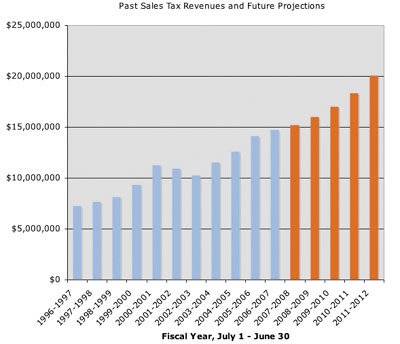The city came up just short of its eight-figure sales tax
projection last year, and its premiere economic authority said he
expects Gilroy’s moderately priced retail base to continue holding
its own throughout 2008.
The city came up just short of its eight-figure sales tax projection last year, and its premiere economic authority said he expects Gilroy’s moderately priced retail base to continue holding its own throughout 2008.
“We were helped out by the affordable retailers that did not see the hits that the Nordstrom’s and Gaps have experienced,” said Larry Cope, president of Gilroy’s nonprofit Economic Development Corporation. Cope was referring to the “cost-conscious” retailers on the east side such as Costco, Target, Wal-Mart and Kohl’s.
He cautioned, though, that Gilroy is not bullet proof. As money continues to leave the economy, there will be less construction money circling around, which could continue to affect Gilroy just as it has the rest of the country, Cope said. But what helps the city is its mix of retailers, which have historically weathered tough economic times.
While Gilroy did not experience astronomical growth last year – sales tax revenue for the 2007 calendar year rose 3.9 percent over 2006 – the city’s sales tax base has risen by almost 89 percent since 1998, with a whopping 18 percent gain between 2004 and 2005, according to city figures. Sales tax revenue for fiscal year 2006-2007 totaled $14,540,541, just shy of the city’s budgeted prediction: $14,764,188. Still, more and more retail on the east side continues to siphon business away from downtown Gilroy, merchants there say. Speaking with retailers all over the city, though, Cope said most are concerned with the future, not the past.
“Sales have maintained, but at the same time, nobody knows what Pandora’s box could bring this next year,” Cope said.
Starbucks exhibited such hesitation earlier this year when it announced it would scale back its domestic expansion and spend time re-training staff: a back-to-basics approach after monumental domestic and global expansion throughout the 21st century.
In February the Westfield Group withdrew all of its development applications for 108 acres of open space outside the city and instead made plans to build a portion of its once-mammoth mall within city limits.
Westfield representatives declined to say why the multi-billion-dollar Australian company decided to scale back its business venture, but many city officials pointed to a looming recession.
Westfield representatives remained reticent: “Westfield continues to evaluate opportunities and options in Gilroy, but declines to comment further,” Westfield’s executive vice president of communications, Catharine Dickey, wrote in an e-mail.
Either way, Cope is still going to Las Vegas, Nev., in May to attend the four-day Global Retail Real Estate Convention. He will rub elbows with 50,000 people representing retailers, restaurants, economic development corporations and cities.
But Cope has found that he often does not have to recruit retailers for Gilroy’s east side market.
The McCarthy family does most of this now, filling 16 acres along Pacheco Pass Highway with retail stores and parking spaces and another 90 acres with office and industrial space. The 10-acre Gilroy Crossing Shopping Center and Gilroy Foods sandwich the new shopping-business center.
So far the niche-market Tractor Supply Store is the only open business in the McCarthy Business Park & Retail Center, but a Sonic, Starbucks and Del Taco are likely to join soon, according to Tom Nelson, a retail specialist with Colliers International: the commercial real estate consulting company the McCarthy family hired to find tenants.
“Gilroy is a regional retail destination,” Nelson said, referring to the Target and Kohl’s next door, the Gilroy Premium Outlets farther north and the Super Wal-Mart and Pacheco Pass Shopping Center across the street.
Colliers’ director for retail, Jim McMasters, said he believes this is the next major junction for job creation in the Gilroy area.
“We thought maybe the area would be over retail, but it isn’t,” McMasters said.
This is what Cope meant when he said east side retail creates itself. “What I do is recruit for downtown,” Cope said. Well, downtown, and high technology, too, because the EDC is chartered primarily to find industrial and commercial jobs. But Cope attends retail shows, he said, to keep connections for other businesses coming to Gilroy.
Earlier this month Cope surprised many in Gilroy with his announcement that an East Coast bio-energy company blazing the way forward in aviation technology will come to Gilroy. The Solena Group, based in Washington, D.C., plans to build the world’s first commercial-scale, renewable jet fuel production plant using biomass and trash.















